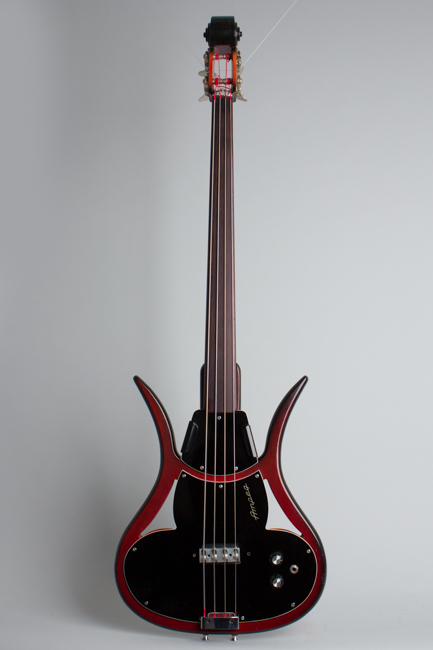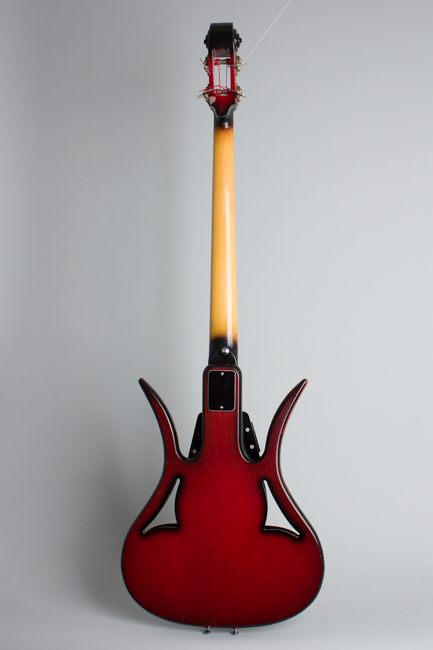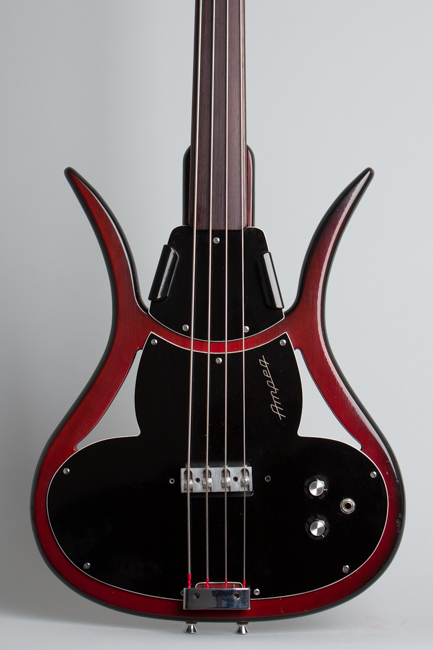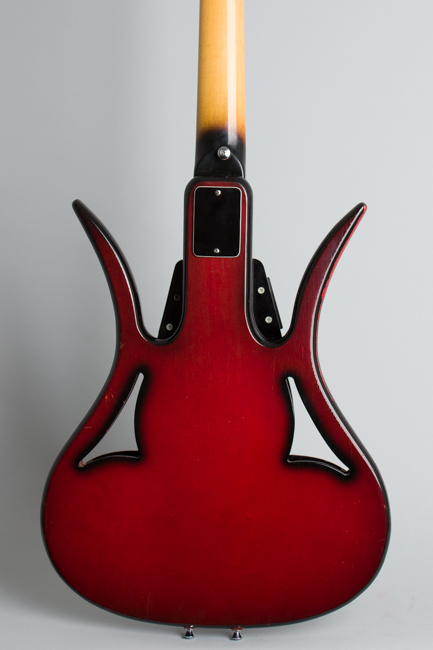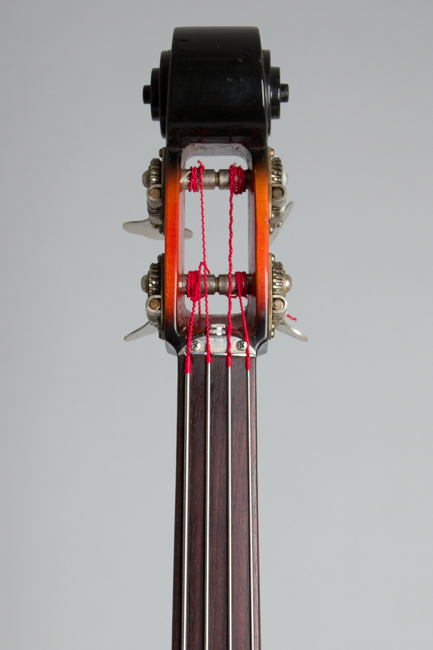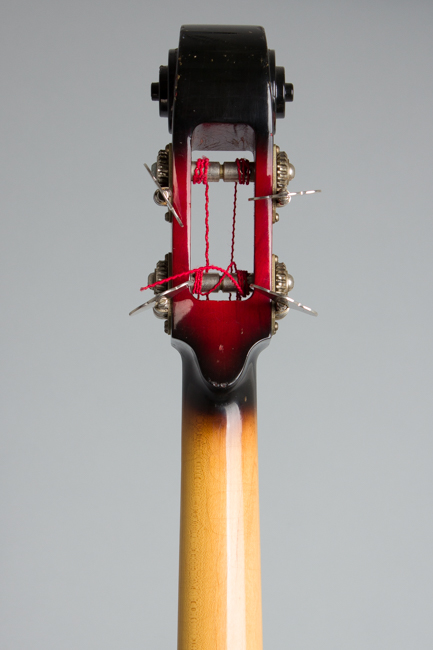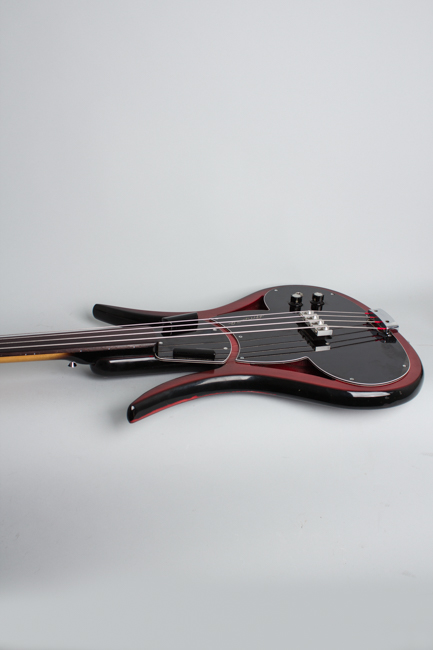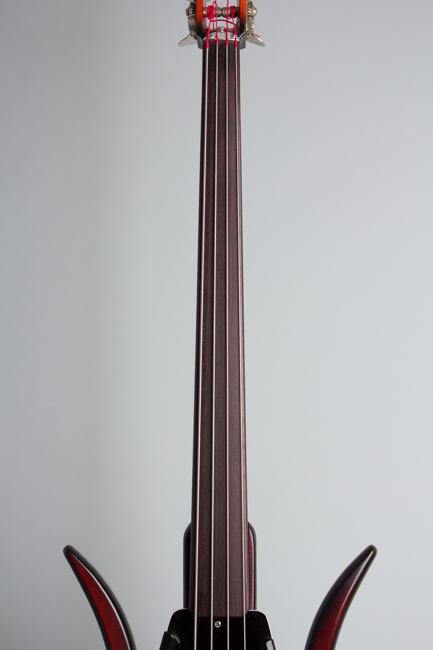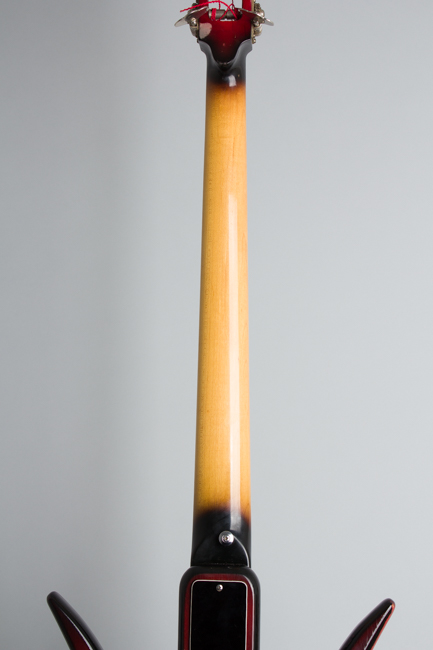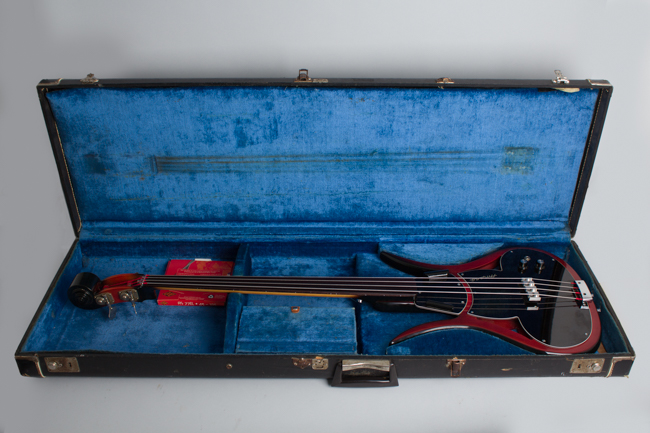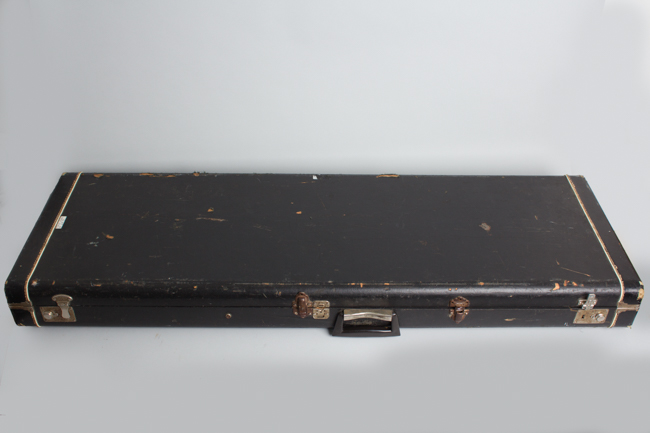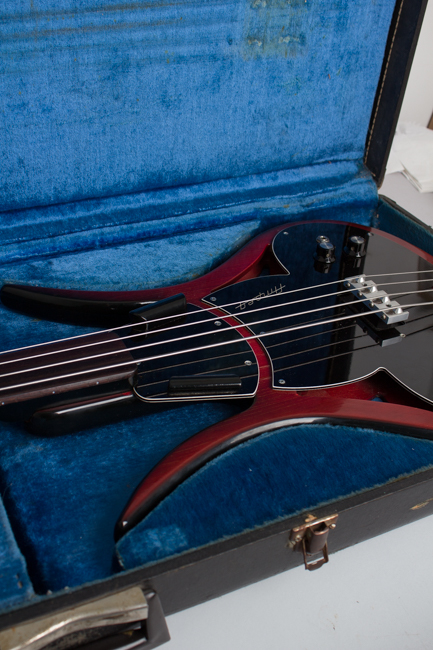Ampeg AUSB-1 Electric Bass Guitar (1967)
Ampeg AUSB-1 Model Electric Bass Guitar (1967), made in Linden NJ, serial # 788, red/black sunburst finish, laminated maple body, maple neck with ebony fingerboard, original black hard shell case.
This is a superb example of one of the strangest instruments to come out of New Jersey in the 1960s, and that's saying something! The original fretless Ampeg AUSB-1 (Ampeg Unfretted "Special" Bass #1) was the company's rarest production "horizontal" bass. This eye-popping design has unsurprisingly earned the nickname "The Devil Bass" for obvious reasons; our old friend "Big" Bob Guida attributed that name to J.B. Hutto, with whom he played one of these unmistakable creations back in the '70s.
Ampeg had prospered with amplifiers since the 1950s, but made only half-hearted attempts to market instruments before 1966. After the fiberglass upright electric "Baby Bass" in 1961 they dabbled with importing re-branded Burns of London guitars. Following that Ampeg decided to create a unique original design just for bassists. The distinctive "scroll' basses were launched at the 1966 NAMM show with some fanfare and have become a '60s classic, although never mounting serious competition to the Fender Precision or Jazz bass.
The bulk of the design was primarily by Dennis Kager, but the body of this model was the brainchild of another Ampeg employee, Mike Roman. The swooping horns allow total access to the entire fretboard and beyond, and of course look extremely wicked in the process. Ampeg bass designs were shaped by company founder Everett Hull's distaste for the Fender bass. Hull was a purist who considered the upright bass to be the legitimate low end instrument, and wanted to cater to traditional jazz and even classical players. To this end the first Ampeg "Horizontal Basses" do not have an understring magnetic pickup but utilize the same vibration-activated "Mystery Pickup" beneath the bridge as the upright Baby Bass, allowing use of gut strings as well as steel. This point Hull insisted on, much to the chagrin of his employees who knew rock'n'roll players were the mass market. The unique scrolled headstock was another nod to bass tradition added on to Kager's design, which has been a defining feature ever since.
Ampeg had these in production by late 1966, offering fretted and fretless models of the more conventional AEB-1 and AUB-1, with these alternate "Devil" models designated ASB-1 and AUSB-1. This bass is a wonderful example of the fretless AUSB-1, the rarest of the lot. They were considered an 'alternate design' to the offset, F-hole body models and only produced in tiny numbers compared, most estimates are a couple of dozen at best.
The body is built of laminate woods; the most notable feature is of course the huge swooping horns, with further open areas carved out underneath. The pickguards are hard signmaker's plastic, with a cut-through Ampeg logo below the strings. There are large wooden handrests above and below the strings and tone and volume controls in a conventional location. The bridge unit is milled aluminum adjustable for height and intonation. The strings run to a separate heavy tailpiece which can be adjusted for string tension. This setup requires special extra-long strings, although the scale length is the same as a Fender at 34". The serial number is stamped under the tailpiece bar.
The scroll-headed maple neck has a plain rosewood fingerboard inlaid on the top edge with tiny position dots. The fretless electric bass was a genuine innovation in 1966, designed for upright players and offering the familiar microtonal fingerboard, a direct opposite to Fender's fretted "Precision" bass. Unfortunately in the ever higher-volume playing environments of the late 1960s, the rather microphonic pickup proved somewhat impractical. Pickup oddities aside, the rest of the design is extremely well-engineered and quite functional.
This bass has a sound somewhere in between a fretless bass guitar and an upright. The acoustic-y twang of the "mystery" unit can be mellowed using the volume and tone controls, but it takes some expperimentation with the amp to understand how to get a variety of sounds from the instrument. The combination of the fretless fingerboard and special pickup can create a convincing electric upright sound if used carefully, just as Everett Hull envisioned. While admittedly not to every taste, the AUSB-1 is one of the most striking and unusual electric basses ever made, a connoisseur's delight with a unique character and history.
Overall length is 47 in. (119.4 cm.), 14 1/2 in. (36.8 cm.) wide at lower bout, and 1 1/4 in. (3.2 cm.) in depth, measured at side of rim. Scale length is 34 1/2 in. (876 mm.). Width of nut is 1 5/8 in. (41 mm.).
This bass shows some fairly minor wear overall but remains nicely original and unaltered. Ampeg "Scroll" basses have often fallen into disrepair or been modified over the last 50+ years; it is a treat to find a well-preserved original. The bass has some typical fairly heavy linear finish checking but by and large the original lacquer is well-preserved. Ampeg were new to finishing wood in 1966 and many early examples have significant finish loss. This bass is mostly free of this; there is chipping along the upper rim along the laminate line, with a similar situation inside the upper cutaway. Other than this the body shows mostly just small dings and dents, some of them discreetly touched up.
Beyond that, the bass has just light general play wear overall. The back of the neck and headstock are lightly checked but show very little wear beyond tiny chips and dings. The hard plastic pickguard has some tiny chips as well but no notable wear spots. The fingerboard shows some light string markings but is generally well-preserved. The bass is set up with flatwound strings to avoid further fingerboard wear.
All hardware is also original; the sliding bridge cover and mounting bolts are gone but everything else is still intact and working. This AUSB-1 a very good player, eccentric-sounding for sure, but it performs exactly as intended. A superb example of this unique New Jersey creation, one of the most interesting and distinctive of all vintage American basses. The large and somewhat cumbersome original HSC is included, somewhat worn with some latch additions but still fully functional. Overall Excellent - Condition.
This is a superb example of one of the strangest instruments to come out of New Jersey in the 1960s, and that's saying something! The original fretless Ampeg AUSB-1 (Ampeg Unfretted "Special" Bass #1) was the company's rarest production "horizontal" bass. This eye-popping design has unsurprisingly earned the nickname "The Devil Bass" for obvious reasons; our old friend "Big" Bob Guida attributed that name to J.B. Hutto, with whom he played one of these unmistakable creations back in the '70s.
Ampeg had prospered with amplifiers since the 1950s, but made only half-hearted attempts to market instruments before 1966. After the fiberglass upright electric "Baby Bass" in 1961 they dabbled with importing re-branded Burns of London guitars. Following that Ampeg decided to create a unique original design just for bassists. The distinctive "scroll' basses were launched at the 1966 NAMM show with some fanfare and have become a '60s classic, although never mounting serious competition to the Fender Precision or Jazz bass.
The bulk of the design was primarily by Dennis Kager, but the body of this model was the brainchild of another Ampeg employee, Mike Roman. The swooping horns allow total access to the entire fretboard and beyond, and of course look extremely wicked in the process. Ampeg bass designs were shaped by company founder Everett Hull's distaste for the Fender bass. Hull was a purist who considered the upright bass to be the legitimate low end instrument, and wanted to cater to traditional jazz and even classical players. To this end the first Ampeg "Horizontal Basses" do not have an understring magnetic pickup but utilize the same vibration-activated "Mystery Pickup" beneath the bridge as the upright Baby Bass, allowing use of gut strings as well as steel. This point Hull insisted on, much to the chagrin of his employees who knew rock'n'roll players were the mass market. The unique scrolled headstock was another nod to bass tradition added on to Kager's design, which has been a defining feature ever since.
Ampeg had these in production by late 1966, offering fretted and fretless models of the more conventional AEB-1 and AUB-1, with these alternate "Devil" models designated ASB-1 and AUSB-1. This bass is a wonderful example of the fretless AUSB-1, the rarest of the lot. They were considered an 'alternate design' to the offset, F-hole body models and only produced in tiny numbers compared, most estimates are a couple of dozen at best.
The body is built of laminate woods; the most notable feature is of course the huge swooping horns, with further open areas carved out underneath. The pickguards are hard signmaker's plastic, with a cut-through Ampeg logo below the strings. There are large wooden handrests above and below the strings and tone and volume controls in a conventional location. The bridge unit is milled aluminum adjustable for height and intonation. The strings run to a separate heavy tailpiece which can be adjusted for string tension. This setup requires special extra-long strings, although the scale length is the same as a Fender at 34". The serial number is stamped under the tailpiece bar.
The scroll-headed maple neck has a plain rosewood fingerboard inlaid on the top edge with tiny position dots. The fretless electric bass was a genuine innovation in 1966, designed for upright players and offering the familiar microtonal fingerboard, a direct opposite to Fender's fretted "Precision" bass. Unfortunately in the ever higher-volume playing environments of the late 1960s, the rather microphonic pickup proved somewhat impractical. Pickup oddities aside, the rest of the design is extremely well-engineered and quite functional.
This bass has a sound somewhere in between a fretless bass guitar and an upright. The acoustic-y twang of the "mystery" unit can be mellowed using the volume and tone controls, but it takes some expperimentation with the amp to understand how to get a variety of sounds from the instrument. The combination of the fretless fingerboard and special pickup can create a convincing electric upright sound if used carefully, just as Everett Hull envisioned. While admittedly not to every taste, the AUSB-1 is one of the most striking and unusual electric basses ever made, a connoisseur's delight with a unique character and history.
Overall length is 47 in. (119.4 cm.), 14 1/2 in. (36.8 cm.) wide at lower bout, and 1 1/4 in. (3.2 cm.) in depth, measured at side of rim. Scale length is 34 1/2 in. (876 mm.). Width of nut is 1 5/8 in. (41 mm.).
This bass shows some fairly minor wear overall but remains nicely original and unaltered. Ampeg "Scroll" basses have often fallen into disrepair or been modified over the last 50+ years; it is a treat to find a well-preserved original. The bass has some typical fairly heavy linear finish checking but by and large the original lacquer is well-preserved. Ampeg were new to finishing wood in 1966 and many early examples have significant finish loss. This bass is mostly free of this; there is chipping along the upper rim along the laminate line, with a similar situation inside the upper cutaway. Other than this the body shows mostly just small dings and dents, some of them discreetly touched up.
Beyond that, the bass has just light general play wear overall. The back of the neck and headstock are lightly checked but show very little wear beyond tiny chips and dings. The hard plastic pickguard has some tiny chips as well but no notable wear spots. The fingerboard shows some light string markings but is generally well-preserved. The bass is set up with flatwound strings to avoid further fingerboard wear.
All hardware is also original; the sliding bridge cover and mounting bolts are gone but everything else is still intact and working. This AUSB-1 a very good player, eccentric-sounding for sure, but it performs exactly as intended. A superb example of this unique New Jersey creation, one of the most interesting and distinctive of all vintage American basses. The large and somewhat cumbersome original HSC is included, somewhat worn with some latch additions but still fully functional. Overall Excellent - Condition.
